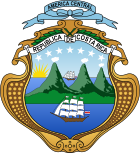Liberal State
| Liberal State | |||
|---|---|---|---|
| 1870–1940 | |||
Costa Rican liberals | |||
Chronology
| |||
 |
|---|
|
|
The Liberal State is the historical period in
The arrival of the
During this stage of national history, the development of a
Development of the Liberal State 1870 - 1929

In 1870,
In 1876
Upon the death of Fernandez in office, the government passed to
During the government of Soto, the
The government of Rodríguez Zeledón was characterized by arbitrary actions in the exercise of its functions. During his government the monument to
During the second period of Rafael Yglesias, in 1900, the tramway was inaugurated in San José, the first Costa Rican novels were published (El Moto and Las Hijas del Campo, by Joaquín García Monge) and the first car was introduced, property of Enrique Carranza . In 1902, Yglesias was succeeded by Ascensión Esquivel Ibarra, whose government was austere and with a severe saving. During this government, the current letter of the National Anthem, written by José María Zeledón Brenes, was adopted.[5]

In 1906 began the first term of
In 1914
Tinoco's downfall began in 1919, when the population of the Great Central Valley - headed by educators such as Carmen Lyra, high school students and workers - took to the streets to protest against an exaction that the government intended to make in the salaries of the teachers, and proletarians. The demonstrations and parades ended up igniting "La Información", a newspaper at the service of the dictatorship.[6] A few weeks later, the brother of the dictator and Minister of War José Joaquín Tinoco Granados, was murdered in the corner of his house by a stranger and a few days later, the dictator, his family and his closest people, were exiled from the country and established in France, leaving the country ruined and exhausted.
After the interim governments of
In 1921 the country was involved in an armed conflict with the Republic of Panama known as the Coto War. In 1922, the International Bank was declared the only currency issuing entity, and one year later, Costa Rica would obtain an important judicial victory against Great Britain in the arbitration litigation ruled by the Taft Judgment.[6]
In 1924, Ricardo Jiménez is re-elected President of the Republic. During this period, he created the National Insurance Bank (now the National Insurance Institute) and the Mortgage Credit Bank. He promoted livestock and agriculture, created the School of Agriculture and the Ministry of Health. He initiated the electrification of the railroad to the Pacific and the construction of the new pier of Puntarenas.[6] In 1928 Cleto González Víquez is newly elected. During this administration the paving of the streets of San José began, improved some roads in the Central Valley, and finished the work of electrification of the railroad to the Pacific.
Crisis of the Liberal State 1929 – 1940

Costa Rica of the nineteenth century, liberal and believer in the ideology of progress, was built on the principle that, released from market forces, an economy based on agricultural exports would lead to civilization and prosperity for all. However, the context of world crisis embodied by the
In 1929, the government of Ricardo Jiménez had to face a difficult fiscal situation, which had spread to all the countries of the world as a result of the Great Depression initiated in the
By 1932, Ricardo Jiménez ruled once again, during his third period, during which he took the pipeline from Ojo de Agua to the port of Puntarenas. He built large buildings for primary schools and numerous roads to various parts of the country, the National Stadium and the Post Office.[6] In general, the periods of government of Cleto González Víquez and Ricardo Jiménez Oreamuno are remembered as stable and of social peace.
In 1936
Finally, the coming to power reformist leader
See also
References
- ^ a b "Costa Rica. El golpe de Tomás Guardia (1870) y la etapa liberal (1871- 1940)". EUMED. Retrieved 22 December 2018.
- ^ a b González Chaves, Daniel (2014). "Los partidos políticos en Costa Rica: un acercamiento histórico". Revista Asociación para el Fomento de los Estudios Históricos en Centroamérica. Archived from the original on 2015-06-20.
- ISBN 9789977672908.
- ^ Cañas Escalante, Alberto; Fernández Durán, Roberto; Fernández Escalante, Álvaro. Nuestros presidentes y jefes de estado 1821-1986. Litografía Trejos.
- ^ a b c d e f g h Vega Carballo (1986, p. 236). "Costa Rica. El golpe de Tomás Guardia (1870) y la etapa liberal (1871- 1940)".
{{cite web}}: CS1 maint: numeric names: authors list (link) - ^ a b c d e f g h i j k l m n o Salazar, Jorge Mario. "Estado liberal y luchas sociales en Costa Rica: 1870-1920". Archived from the original on 2013-12-15. Retrieved 2018-12-26.

